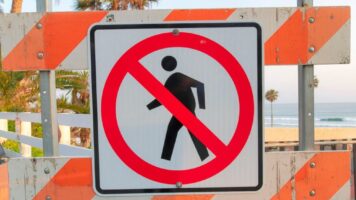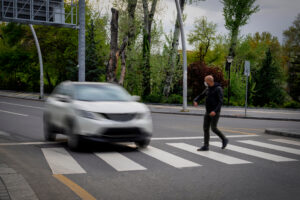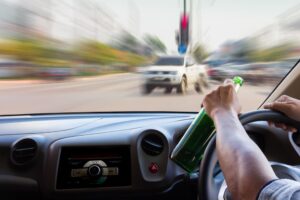A walk can be one of life’s simplest pleasures. Whether it’s a stroll through Capaha Park in Cape Girardeau or a walk to a local shop in downtown Sikeston, the act of putting one foot in front of the other connects us to our community and gives us a moment of peace. You expect to be safe. You expect drivers to be paying attention. You certainly never expect that a simple walk could end in a moment of terror, pain, and confusion.
But for too many people in Southeast Missouri, that is the reality. A pedestrian accident is a deeply traumatic event that shatters your sense of security and leaves you with physical injuries, emotional scars, and a mountain of questions. You may be lying in a hospital bed or at home trying to recover, wondering, “How did this even happen?”
Understanding the common causes of pedestrian accidents can be the first step on the long road toward healing and justice. Contact a seasoned pedestrian accident attorney in Cape Girardeau in your case.
The Overwhelming Factor: Driver Negligence and Error
While accidents can be complex, the vast majority of pedestrian collisions trace back to one primary source: the actions—or inactions—of the person behind the wheel. A two-ton vehicle is a powerful machine, and the person operating it has a legal and moral duty to exercise extreme care, especially around those on foot. When they fail in that duty, the consequences are catastrophic for the pedestrian.
Distracted Driving: The Modern Epidemic
This is perhaps the single most prevalent and dangerous behavior on our roads today. We see it everywhere—drivers with their heads down, their attention consumed by a small screen instead of the world around them. Distracted driving is more than just texting. It includes:
- Using a smartphone: Texting, emailing, scrolling social media, or looking at maps.
- Interacting with the car’s infotainment system: Adjusting the radio, navigation, or climate controls.
- Eating and drinking: A driver unwrapping a burger is not a driver focused on the road.
- Speaking with passengers: A heated or deep conversation can divert critical mental focus away from the task of driving.
- Personal grooming: Applying makeup or adjusting hair in the rearview mirror.
For a pedestrian, a driver’s split-second distraction is the difference between being seen and being hit. A driver traveling at just 35 mph covers the length of a football field in about six seconds. A five-second glance at a text message means they have driven that distance completely blind. They won’t see you stepping into a crosswalk in Scott City. They won’t notice your child chasing a ball into the street.
This form of negligence is a conscious choice, and it leaves victims with life-altering injuries because someone else’s text was more important than their safety.
Speeding and Aggressive Driving
Speed limits aren’t suggestions; they are laws designed to allow for adequate reaction time and to minimize the force of impact if a collision occurs. When drivers speed, they rob themselves of the time needed to stop for a pedestrian. This is especially true in residential areas, school zones, and downtown districts where people are frequently walking.
The physics is unforgiving. A pedestrian hit by a car at 20 mph has a high chance of survival. At 40 mph, that chance plummets. Speeding drastically increases stopping distance and transforms a preventable accident into a fatal one.
Aggressive driving goes hand-in-hand with speeding. This includes behaviors like tailgating, weaving through traffic, and running yellow lights. An aggressive driver is an impatient driver, and they often fail to yield to pedestrians who have the right-of-way because they are in a hurry. They may whip around a turning car without seeing the person crossing the street in front of it, leading to a truly horrific and completely avoidable collision.
Failure to Yield the Right-of-Way
In Missouri, the law is clear about who has the right-of-way in many situations, and it is often the pedestrian. Unfortunately, many drivers either don’t know the law or simply ignore it. The most common scenarios include:
- At Marked Crosswalks: These painted lines are a clear signal that pedestrians may be present. Drivers are legally required to stop and let pedestrians cross. Too often, they speed up to “beat” the person or simply don’t look.
- At Unmarked Crosswalks: Many people don’t realize that nearly every intersection is considered an unmarked crosswalk. If a pedestrian is crossing at an intersection without traffic signals, drivers are still obligated to yield.
- During Turns: Left-hand turns are particularly notorious for causing pedestrian accidents. The driver is often focused on finding a gap in oncoming traffic and completely fails to scan the crosswalk they are about to enter. Right turns on red are also dangerous, as drivers are looking left for cars, not right for people.
When you are lawfully crossing the street and a driver fails to yield, the fault is not yours. You were following the rules, and their negligence put your life in danger.
Driving Under the Influence (DUI/DWI)
This is one of the most reckless and selfish acts a driver can commit. Alcohol, marijuana, prescription medications, and illegal drugs all severely impair a driver’s ability to operate a vehicle safely. Impairment leads to:
- Slowed reaction time
- Blurred vision or reduced peripheral vision
- Poor judgment and decision-making
- Loss of coordination
- Drowsiness
An impaired driver is incapable of recognizing and reacting to a pedestrian in their path. For the victim, being hit by a drunk or drugged driver adds a layer of deep injustice to the trauma. The accident wasn’t just an “accident,” it was the direct result of a criminal choice.
Drowsy Driving
Often called the “other DUI,” drowsy driving can be just as deadly. A driver who is sleep-deprived experiences similar impairments to an intoxicated one. They can suffer from “microsleeps”—brief periods of sleep lasting several seconds, where they are completely unaware of their surroundings.
This is a significant risk on the highways crisscrossing our SEMO region, like I-55, where long-haul truckers or weary commuters are traveling long distances. A drowsy driver can easily drift onto the shoulder or through an intersection, striking a pedestrian without ever even hitting the brakes.
Environmental and Infrastructure-Related Causes
Sometimes, the environment itself can contribute to an accident. While the driver still has a responsibility to adjust to conditions, these factors can make a dangerous situation even worse.
Poor Lighting and Nighttime Conditions
The vast majority of fatal pedestrian accidents occur at night. Under the cover of darkness, it is much harder for a driver to see a person on the road, especially if that person is wearing dark clothing. Many rural roads in Southeast Missouri lack streetlights, creating pitch-black conditions.
However, drivers have a responsibility to use their headlights properly and to drive at a speed that allows them to stop within the illuminated distance of those headlights. Out-driving your headlights is a form of negligence.
Poorly Maintained or Inadequate Infrastructure
Our towns and counties have a responsibility to provide safe infrastructure. When they fail, pedestrians pay the price. Common issues include:
- Lack of Sidewalks: In many areas, particularly older neighborhoods or rural towns, there are no sidewalks. This forces people to walk in the street or on a narrow, uneven shoulder, placing them directly in the path of traffic.
- Faded Crosswalks: Crosswalk paint needs to be maintained. When it becomes faded and chipped, it’s much harder for drivers to see, diminishing its effectiveness as a safety feature.
- Lack of Pedestrian Signals: Busy intersections need signals that tell pedestrians exactly when it is safe to cross. Without them, people are left to guess, often with tragic results.
- Visual Obstructions: Overgrown trees or shrubs on a corner can block a driver’s view of a pedestrian waiting to cross. Illegally parked vehicles can create a similar blind spot, forcing a pedestrian to step out from behind a large truck or van into moving traffic.
Inclement Weather
Rain, fog, snow, and ice make driving more hazardous for everyone. Visibility is reduced, and roads become slick, significantly increasing the distance it takes for a car to stop. A responsible driver slows down and increases their following distance in bad weather. A negligent driver continues at normal speed, unable to stop in time when a pedestrian appears through the rain or fog.
What If I Believe I Was Partially at Fault?
After an accident, it’s natural to replay the events over and over in your mind. In this process, you might worry that something you did—or didn’t do—contributed to the collision. Perhaps you were crossing mid-block, you were distracted by a phone call, or you hesitated in the road. It’s a heavy weight to carry, and it often leads victims to a painful conclusion: “It was my fault, so there’s nothing I can do.”
Please, do not let that thought stop you from seeking help. In Missouri, the law is designed to be more nuanced and compassionate than that.
Missouri follows a legal rule known as “pure comparative negligence.” This may sound like a complex legal term, but its meaning is simple and incredibly important for your case: you can still recover financial compensation for your injuries even if you are found to be partially at fault for the accident.
Here’s how it works: In a personal injury case, a court or jury will look at the actions of everyone involved and assign a percentage of fault to each person. Under pure comparative negligence, your total compensation award is simply reduced by your percentage of fault. So, if you are found to be 20% at fault for your injuries, your damages would be reduced by 20%.
Why is this so important? Because you can be certain that the driver’s insurance company will do everything in its power to shift as much blame as possible onto you. They will seize on any detail—the color of your clothing, the fact you were listening to music, where you chose to cross—to argue that you are the one responsible. Their goal is to reduce or completely deny your claim.
This is where having a skilled personal injury attorney becomes essential. An experienced lawyer will conduct a thorough investigation to build the strongest possible case proving the driver’s negligence while minimizing any percentage of fault that could be unfairly assigned to you. They know the tactics insurance companies use and how to effectively counter them.
Do not let an insurance adjuster convince you that you have no case. Understanding your rights under Missouri’s pure comparative negligence law is the first step toward securing justice and compensation.
Seeking Justice After a Pedestrian Accident
When your life has been turned upside down by a pedestrian accident, you need more than just a lawyer; you need a compassionate advocate who understands the local legal landscape of Southeast Missouri and, more importantly, understands what you are going through.
At Cook, Barkett, Ponder & Wolz, we are dedicated to fighting for justice with experience and client care. Our attorneys have over 100 years of combined trial experience serving clients in Cape Girardeau, Bloomfield, Sikeston, and across the SEMO region. We have the deep-rooted local knowledge and the resources to handle complex cases against powerful insurance companies. Our success comes from not just knowing the law, but from taking the time to know you and your story.
If you or a loved one has been injured in a pedestrian accident, contact our dedicated personal injury lawyers today at (573) 335-6651 or through our online form for a free consultation. Let us stand by your side, fight for your rights, and help you and your family move forward.






